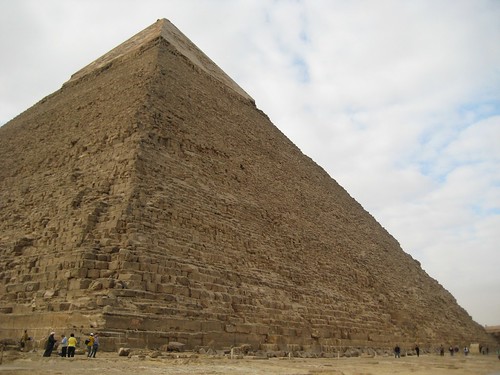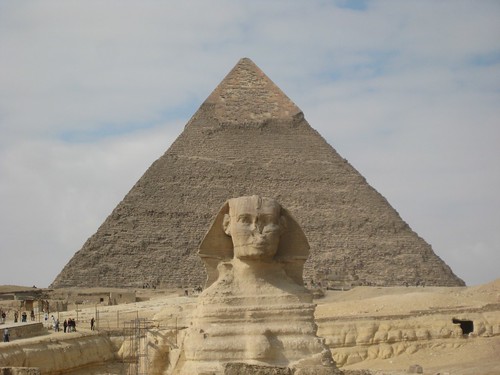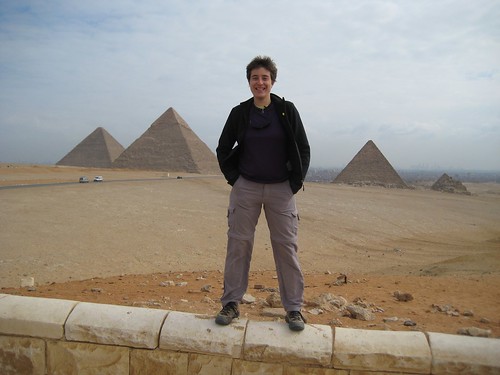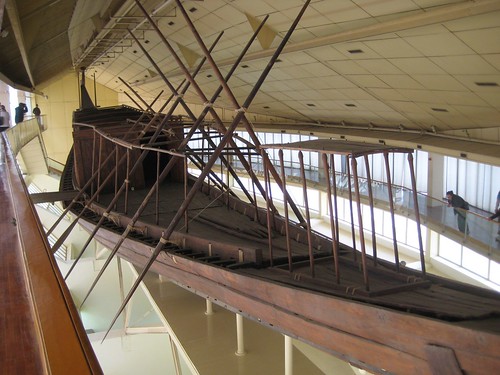Lower Egypt really is positively crammed with blockbuster tourist attractions – Cairo alone boasts the pyramids at Giza, the Sphinx, and the Egyptian Museum, which features the treasures from King Tut’s tomb. (Confusingly, “Lower Egypt” refers to the north of the country, because though it’s at the upper part of the map, it’s downstream relative to the Nile, and in Egypt, it’s all about the Nile). Anyway, it’s impossible not to be impressed on one hand, and simply overwhelmed on the other. I tended towards the overwhelmed end of the scale, but this may be because the tour I’m on now is setting a punishing pace, and I’m simply getting frayed. We’re moving around every day, staying in a different hotel every night, and we’ve got almost no free time. It is nice not to have to worry about finding accommodations or getting to the different sights, or even finding breakfast, but this convenience comes with a price, and these days that price feels too high.
For instance all the sights I mentioned above – the pyramids, the Sphinx and the entire Museum – were packed into one day, before we hopped back to the hotel, had a group dinner, and then got on a perfectly miserable overnight train. (The train itself was reasonable, if grimy, with large seats and lots of leg room. The problem was that the temperature on board dropped steadily from fresh to chilly to arctic during the night. This made it difficult to sleep for anyone not accustomed to dossing on a chair in a meat locker. I’d actually bought a couple of blankets in Cairo in preparation for spending the night on a felucca on the Nile in a few days, which should have helped the situation a lot. The blankets on display in the shop were a bit small, but I bought two. When I opened them up on the train it turned out that the blankets on the display and the blankets I bought (stacked directly underneath the ones on display) were two different things. I was, in fact, the proud owner of two postage stamp-sized baby blankets, which did little to keep me warm on the train and will be perfectly useless on the felucca. I abandoned them in the hotel in Luxor with bitter disappointment. No decision yet on whether I will brave the felucca with whatever fetid and ancient blankets might be available, or whether I give in to my better judgment and skip the whole thing in favour of an upgrade to a hotel. Odds-makers would favour the hotel, especially since I really feel like I’ve done my time sleeping al fresco and deserve every upgrade available at this point.)
 One of the offending blankets. £66 down the drain (about $12.00).
One of the offending blankets. £66 down the drain (about $12.00).
Ok whining over for now, back to Cairo. The pyramids were impressive, but I hope I don’t sound too jaded and horrible if I say they were actually smaller than I expected. And though every guide book on the planet mentions it, it was still startling to see them rise up out of the modern suburb of Giza. They really are in the middle of the city! The most impressive thing about the pyramids is really their beautiful geometric perfection relative to their age. About 5,000 years old, they were built without the use of the wheel, the block and tackle, or any iron tools. Impressive.
 Pyramid pic. Ok, maybe they are pretty big.
Pyramid pic. Ok, maybe they are pretty big.
In fact, the best part of the sight was the trip inside the pyramid of Khafre (a bit smaller than the Great Pyramid of Cheops, but also only £30 to enter, instead of £100. We were reliably informed that there was little difference between the two from the inside.) Going inside involved a trip down a long sloping corridor that required an uncomfortable stooping posture. (GSRED Traveler Tip: Try going down the tunnel backwards, like going down a ladder. This way the natural shape of your posture matches the slope of the corridor.). After descending there was a short level passage and then a corridor sloping up to the burial chamber. The chamber itself was surprisingly plain – no decoration, no paintings, no adornments of any kind. The stone sarcophagus was placed at one end of the room, lid open, and empty. Otherwise, the room – about 15’ x 30’, was completely empty. In fact, the only thing on the walls was a comically large and arrogant painted inscription from the Italian archeologist who discovered the tomb in the 19th century. That was at least 12’ long, with letters about a foot high. Cheeky. I lingered with a couple of people in my group, enjoying having the place to ourselves and soaking up the ambience. Unfortunately we stayed a minute too long and got stuck waiting in the level spot for a group of 9,746 Japanese tourists to descend before we could get out.
After the pyramids, we had a quick look at what purports to be the oldest boat ever discovered. It’s a pharonic funerary barque and was discovered in 1954 and susbsequently reassembled. It was impressive too, and I especially liked seeing how they planks that made up the hull were held together with ropes instead of joinery.
Then we all trooped obediently back to the bus for the short hop to the Sphinx. In fact, they’re as close together as you think they are, but getting between them on foot isn’t really practical. And once again I have to apologize, but it was smaller than I expected. There’s not a lot to see at the sight once you’ve taken in the Sphinx, but Fabio and I enjoyed watching the other tourists striking amusing poses for photographs. The most popular pose was the “blowing a kiss to the Sphinx”, followed closely by the “Appearing to hold up the Sphinx by cleverly placing the outstretched hand in the frame”. (Look over at Flickr to see one photo of mine that includes four, count ‘em FOUR separate Russian tourists all in a line, posing for photos. And yes, there are a couple of me posing too, with the pyramids. But no kisses.)
 Obligatory shot of the Sphinx and a pyramid
Obligatory shot of the Sphinx and a pyramid
After the Sphinx we made a quick pitstop for lunch at a popular take away place. Of course I had falafel, because it’s mandatory in the Middle East to consume your bodyweight in pita bread and chickpeas of some form every day. At least it’s cheap – my lunch was one small pita with falafel and one small pita with fried eggplant and cost a total of £3 (about 67 cents).
The Egyptian Museum, where we went after lunch, was large and dusty and hard to handle. I’ve been in a lot of museums by now, and this one definitely falls into the “well-intentioned but underfunded” category, which is a real shame given the unbelievable and unique treasures on display. The cases were old-fashioned and sparsely documented, and the number of exhibits was simply overwhelming. It felt like I’d stepped into a time machine and emerged in the 1950s – it was a lot like the museum at the Citadel in Amman, but one hundred times bigger. Then again, I did see the sarcophagus of Amenhotep and all the treasures from King Tut’s tombs. And there are LOTS of those. I think most of the second floor of the museum was King Tut stuff. It was undeniably cool to see the actual contents of the tomb – the many layers of shrines that surrounded the many layers of sarcophagi that surrounded the many layers of coffins that finally surrounded the actual mummy. And there was the furniture and jewelry and statues and such that were piled haphazardly inside the burial chambers. In fact, the most evocative things on display were the black and white photos depicting the tomb when it was first discovered by Howard Carter in 1922. Having been inside a tomb that morning, it was chilling to think about going in there and seeing the vast collection for the first time. And of course I saw the famous golden mask, which was brilliant.
But I was also tired, and the museum was chilly and not long after arriving I realized I’d simply had enough. I waited out the time after that, having a look at some “lesser” sarcophagi, and a few papyrus scrolls, and I admit I also spent a bit of time texting, and I thought about going for a coffee. In the end I had a bit of time back at the hotel to get online and blog and upload some photos. Then it was dinner and the overnight train, and the too-small blankets and all those things I’ve already mentioned. We return to Cairo later in the trip, and I hope to have a bit of time to explore the city then. It may have brilliant sites dating back 4,000 years, but it’s also a busy, dirty, heaving modern city, and I’d like to see some of that too.




2 Comments:
Well, as much as you are burnt out, it still sounds awesome.
I checked out some of your other pics. Dude - you look a little big for that donkey. Or rather - that donkey looks a little small for you. Were your feet on the ground like a Flintstone car?
You look great with the 3 pyramids, and that wonderful slightly long (for you) hair. Happy trails...
Rob H.
Post a Comment